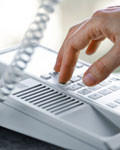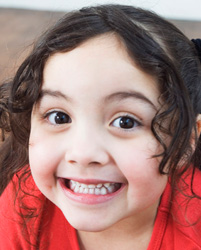Toddler And Pre-Schooler Dental Care
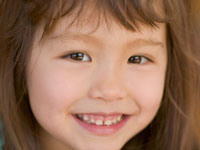
Almost half of the three-year-olds whom I see for a first dental examination have one or more cavities. Primary (baby) teeth do not have the enamel-strengthening advantage of fluoride during their development, because only trace amounts of fluoride pass through the placenta to the fetus. The primary teeth begin to develop during the sixth week and are calcifying at twenty weeks during pregnancy. Infants may be infected with the bacteria that cause tooth decay as early as ten months of age. This occurs when the caretaker tastes or blows on baby's food or by kissing. The decay-causing bacteria are transferred in saliva. Constant exposure of the teeth to juices, milk, or other sweetened drinks, either in a baby bottle or sippie cup, may also cause decay. Early childhood decay may result in a tendency to experience decay for the rest of your child's life. Good oral hygiene is just as important for the primary teeth as it is for the permanent teeth.
Pediatric dentists believe that toothpaste should not be used until after two years of age. A match head-sized amount should be dispensed. Some toothbrushes have a colored area on the brush head to indicate how much toothpaste to use. Do not permit your toddler to eat toothpaste from the tube. If your little one does not like toothpaste, do not use any. The fluoride in toothpaste does help to decrease decay, but sometimes brushing without toothpaste is necessary. Do not use tartar control toothpaste until the teen years. There are too many additives.
Toddler's teeth should be brushed at least once each day. Bedtime is always the most important time to brush the teeth. During the day, saliva flows over the teeth to aid in removing any food residues. Brushing should be done only by the parents, not the toddler or preschooler. A serious injury can result from permitting your child to run with a toothbrush in his or her mouth. Once all 20 primary teeth have erupted (come in), begin to brush after breakfast too. Do not permit your little one to brush first. The benefit of the fluoride in the toothpaste will be lost. Brushing the toothpaste directly onto the tooth's enamel surface will add to fluoride's strengthening effect. The toothbrush is not a toy. Chewing on the bristles will bend them. The brush must be replaced if this occurs, because it can no longer properly remove plaque. The brush should have a small, rounded head with soft bristles.
Most parents find brushing in a seated position to be easiest. Sit on the floor, the bed, or the couch and place your child's head on your lap. If your toddler is not cooperating, wrap one of your legs around both of his/her legs. Use your free hand to hold his/her hands. Your child will probably be protesting with the mouth wide open. Take advantage of the moment and brush! Brushing does not have to take two minutes. Thirty seconds may be enough time to cover all baby tooth surfaces. Do not think about time, just be sure to brush all surfaces.
A back and forth or small circular motion may be used for brushing primary teeth. Covering every tooth surface is most important. If you brush with the same pattern every time, you will be more efficient. Begin with the upper right or left primary molars. Brush from one side of the mouth to the other. Include the chewing surfaces and the side of the teeth next to the roof of the mouth. Move on to the bottom primary molars. Brush in the same manner as the upper teeth, moving from right to left, or vice versa, including the chewing surfaces and the side of the teeth next to the tongue. Ask your little one to close his or her mouth and brush the sides of the teeth all the way around next to the cheeks. Gently pull the bottom lip away from the bottom incisors (front teeth) and brush upward and away from the gum line. You may notice some light staining on these teeth when your little one is taking an oral antibiotic.
If there are no spaces between the primary teeth, flossing should begin. The same reclined position used for brushing should be used for flossing. Pretend like you are the dentist. This can become a time for not only cleaning teeth, but a time for desensitizing your child. Each time you brush or floss, he/she will become more accustomed to being in a reclined position with this activity occurring in his/her mouth. There are so many varieties of floss. If the teeth are tight together, use waxed floss. Your child may like the flavored floss, which also is easy to use with tight teeth. Use a piece of floss the length of your wrist to your elbow. Wrap the floss around your middle fingers on each hand. Palms will face upward for the top teeth and downward for the bottom teeth. Use your thumbs and index fingers to gently slide the floss between the teeth. In this case, begin with the front teeth first because they are easier to reach. Wrap the floss in a C-shape around each tooth and use an up and down motion (not back and forth) to floss. After a short time, you will be a pro! If you can manage to floss each day, that would be great, but two to three times a week is adequate.
No matter how much your child prefers to delay or avoid brushing, do it! It is much better for you to have a battle at home than for your child to experience early decay and have to undergo dental treatment at age two or three. In most cases, decay is preventable. Here's to a cavity-free future!
by Jane A. Soxman, DDS
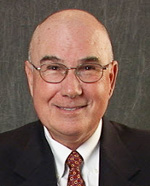
+Jim Du Molin is a leading Internet search expert helping individuals and families connect with the right dentist in their area. Visit his author page.
Dental Care: Toothbrush Tips For Kids
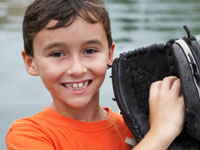
There are so many designs for toothbrushes. How does anyone know what to select? Here are some tips from a pediatric dentist to make the right decision and get the most out of your purchase.
Let's begin with preschoolers. Toothbrushes should have extra soft bristles with small, rounded heads. The handles should be larger for a good grip.
Some toothbrushes have rubber on the handle to make them slip-proof. A colored area on the bristles indicating the correct amount of toothpaste to dispense can be helpful. Do not permit your preschooler to chew on his or her toothbrush or run with a toothbrush in his or her mouth. You should do the brushing until six years of age. No toothpaste should be used until after age two.
The six-year molars erupt (come in) behind the primary (baby) molars in the back of the mouth. When they begin to erupt, it is time for another toothbrush design. This brush should have a larger head to accommodate the larger permanent teeth and a longer tuft of bristles on the end of the head. As the six-year molars erupt, they are lower than the teeth that are beside them. A toothbrush with a longer set of bristles at the end, an end tuft, is better for cleaning erupting molars.
Around age twelve, when the twelve-year molars are erupting, use the same style brush with an end tuft, but the head should be larger.
During orthodontic treatment, a toothbrush that can clean around the braces is necessary. These brushes will have a short row of bristles in the center and two longer rows on the outside. They will clean around the brackets more effectively. A tiny brush, called an interdental brush, is used for cleaning areas that are hard to reach. Your orthodontist will instruct you regarding the extras needed for good dental care during orthodontic treatment.
All brushes, for all ages, should have soft bristles. Hard bristles are hard on gums. As soon as the bristles look frayed, the toothbrush should be replaced. It is impossible to clean teeth properly with a tattered toothbrush. Replacement may be once a month for some heavy-duty brushers and less often for those with a healthier gentle technique.
All toothbrushes should be rinsed thoroughly with hot water before and after brushing. Rinsing toothbrushes has been shown to reduce the growth of bacteria on the bristles between brushing.
Toothbrushes should be replaced after any illness. If a strep infection is being treated, the toothbrush should be replaced. The strep grows on the toothbrush and can re-infect your child. When you pick up your prescription, also pick up two new toothbrushes. Begin a new toothbrush 24 hours after the antibiotic is started and begin the second toothbrush upon completion of the antibiotic. The same holds true for acrylic orthodontic appliances. They must be disinfected during a strep infection because strep grows on appliances too.
Because viruses and bacteria are growing on the toothbrush bristles during an illness, do not touch the toothpaste tube with the bristles of the toothbrush. Place the toothpaste on a clean finger for transfer, or if the child has herpes, place the toothpaste on a cotton swab for transfer to the toothbrush.
What about the power or electric toothbrushes? Do they do a better job of cleaning? Yes, yes, yes! The first electric brush can be used at age six when children begin to do their own brushing. They must be kept clean and the heads should be changed when the bristles become frayed. The head can be soaked in mouthwash containing alcohol for disinfecting if an illness occurs just after starting to use a new brush. Keep all mouthwash out of the reach of children!
Bedtime brushing is the most important time of day. Morning brushing may be done before breakfast, but after breakfast is more important. After you have purchased the appropriate toothbrush for your child, the only thing left is for you to say, at least twice each day, USE IT!!!
By Jane A. Soxman, DDS

+Jim Du Molin is a leading Internet search expert helping individuals and families connect with the right dentist in their area. Visit his author page.
